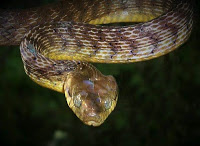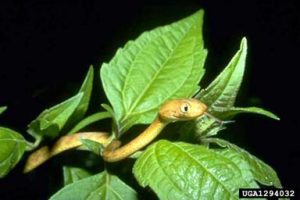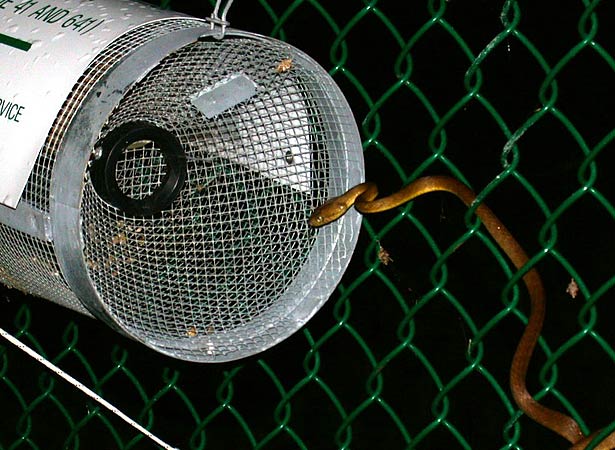Brown Tree Snake
Brown tree snake (Boiga irregularis)
Regulatory Status: Hawaii Injurious Wildlife. Federal Injurious Wildlife
Not known to be established in Hawai’i, Call 911 or 643-PEST immediately to report any snake sighting.
Description
-
Snake with yellowish to dark brown back, sometimes with mottled bands. Underside is cream to yellow colored. Head wider than body, with eyes that are cat-like (the pupils are vertical)
-
Nocturnal, lives mostly in trees, although frequently seen on the ground.
-
Length is 45 cm (18 inches) when first hatches from egg, may grow to 3 m (9 feet) in length, although most frequently 1-2 m (3-6 feet)
-
Able to reproduce at three years of age
-
Native to the South Pacific including the Solomon Islands, New Guinea, and Northern Australia. Believed to have been accidentally introduced to Guam in the 1940s hidden in cargo.
Impacts
-
On Guam, the population of Brown tree snakes (BTS) was once around 50 snakes per acre. It is now estimated to be aro
 und 10-21 BTS per acre. The BTS has a devastating impact on islands that it is not native to because it is not controlled by predators, diseases, or competitors as it is in the snake’s native range.
und 10-21 BTS per acre. The BTS has a devastating impact on islands that it is not native to because it is not controlled by predators, diseases, or competitors as it is in the snake’s native range. -
BTS eat birds, bird and reptile eggs, lizards, small mammals such as rats and mice, and even small household pets. They are responsible for the extinction of 9 of 13 forest bird species and 3 species of lizard. Other species of birds have been reduced to very low numbers and seabirds such as terns, noddys and shearwaters no longer nest on the island.
-
In the absence of preferred prey (birds and small mammals), BTS will feed on lizards and skinks, which reproduce faster and are able to sustain the snake population at abnormally high levels.
-
Ecological impacts of the absence of birds and lizards (largely insect-eating species) include a rise in the abundance of insects, which may affect crop production.
-
The Brown tree snake causes frequent electrical power outages by climbing power lines and getting into transformers and electrical boxes. Snakes have caused more than 1600 power outages in the 20-year period of 1978-1997. Recent estimates reflect that BTS cause nearly 200 outages per year currently. Costs to the island’s economy have exceeded $4.5 M per year over a 7-year period without considering transformers and damages inside electrical substations.
 Distribution:
Distribution:
- Not known to be present in Hawaii at this time, although a total of eight Brown tree snakes have been found live or dead in Hawaii between 1981 and 1998. All snakes were associated with the movement of civilian and military vehicles or cargo from Guam. No special searches were conducted for cargo or crafts as they were leaving Guam or arriving from Guam in Hawaii prior to the 1980s, as the problem on Guam was still coming to light.
- An economic study by the University of Hawai’i estimated that the introduction of the BTS to Hawai’i could cause between $28,500,000 and $405,000,000 annually. A new assessment by the USDA National Wildlife Research Center puts the actual cost of BTS at $1.7 billion per year if introduced to Hawai’i.
Management actions:
- In 2020, the U.S. Department of Interior announced that $3.4 million in grant funding will go towards the suppression and control of BTS in Guam, and towards prevention, detection, and rapid response efforts in Commonwealth of the Northern Mariana Islands and Hawai’i.
What you can do:
If you see a snake, call 911 or 643-pest immediately!
For more information, see:
- Boiga irregularis Datasheet from CABI
- Boiga irregularis information and updates from USDA NISIC
-
Boiga irregularis information from USGS Fort Collins Science Center
-
Boiga irregularis information from National Invasive Species Information Center

